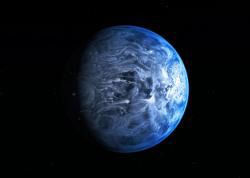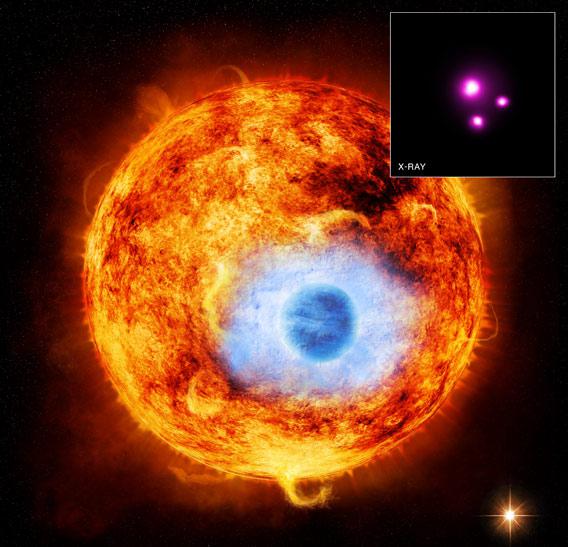About 60 light years from Earth is a binary star system called HD189733. The two stars—one slightly smaller and cooler than the Sun, the other an even dinkier and colder red dwarf—orbit each other, separated by 30 billion kilometers (about seven times the distance from the Sun to Neptune, for scale).
The brighter star, HD 189733A, is known to have a planet. We know quite a bit about this world: It’s slightly larger and more massive than Jupiter, it’s very hot (not surprising; it orbits the star at distance of only 4.6 million km, or 3 million miles), it has fierce winds, and we even know it’s blue, probably due to airborne dust in its atmosphere.
That’s all pretty cool, but the HD 189733b, as it’s called, just got a new notch in its belt: Orbiting telescopes have detected the planet by observing it in X-rays! This is a first for exoplanet research; no other planet has been detected this way.

Artwork by NASA, ESA, M. Kornmesser
Here’s the scoop: The planet orbits the star very closely, and we see the orbit very nearly edge-on (it’s tilted with respect to us by less than 5°). It circles the star every 2.2 days, and every time it does it passes directly between us and the star, blocking a bit of its light. In visible light, the kind we humans can see, the light from the star drops by about 2.4 percent (meaning 2.4 percent of the star’s disk is blocked by the planet). The planet was found by observing the star over and over again, looking for this tell-tale dip in light. In a sense, it’s like the planet is casting a shadow on telescopes here on Earth.
The star is bright in visible light, but it also gives off X-rays as well (stars with magnetic activity, like the Sun, can emit quite a bit of X-ray light). So astronomers targeted HD 189733A with the orbiting XMM Newton and Chandra observatories. They watched the star for a total of nearly two solid days, looking for a corresponding drop in X-rays.
And they found it! In fact, it wasn’t that hard to spot; the amount of X-rays from the star dipped by 6-8 percent, a far larger amount than in visible light. The astronomers attribute that to the planet’s atmosphere being very puffy, the outer layers opaque to X-rays while still letting visible light through. This isn’t too surprising, given how hot the planet is. Air expands when heated, so having an enlarged atmosphere is expected.
I’m pretty impressed by this. It actually adds to our knowledge of the planet quite a bit, because it allows a little more physics to be used to analyze the atmosphere. We suspect that planets like this lose their atmosphere over time because they absorb high-energy light from their stars, which blows away their outer atmosphere. These observations help astronomers how the planetary atmospheres can do this. They estimate HD 189733b is losing mass at a rate of about 200,000 tons per second. That sounds like a lot, but be aware that the total mass of the planet is about 2,000,000,000,000,000,000,000,000 tons (2 x 1024 tons), so it has nothing to worry about for a long, long time. It’ll take something like 300 billion years for the air to all blow away, which is comfortably longer than the current age of the Universe itself.
Isn’t that funny? By looking at a star with a few different telescopes that see light in different ways, we can hang a life expectancy on its planet. Of course, long before that time the star itself will swell up and consume the planet anyway, but still. Think about it: Given enough time, entire planets can be blown away!
SCIENCE! I love this stuff.
